August 2002 // Volume 40 // Number 4 // Ideas at Work // 4IAW5
Secure Seat (SM): A Safe and Systematic Approach to Teaching Riding
Abstract
Secure SeatSM is a skill-driven system for teaching riding
that can be used to teach any type of horse and rider combination to work together
in a comfortable, safe, and efficient manner. It provides an effective method
for achieving and maintaining balance with the horse and thereby provides a
more willing and comfortable mount. Extension educators in 4-H and other program
areas who are involved with rider training should investigate this teaching
system.
Introduction
Secure SeatSM is a way to teach or learn a soft, balanced seat that is effective and comfortable for the horse and rider; it is not a seat in itself or a way to ride. A major aspect that Secure SeatSM teaches the rider is to move with the horse. Many of the problems that riders encounter are a result of their improper position, bad habits, or interference with the horse's natural movement. Extension educators in 4-H and other program areas who are involved with rider training should investigate this teaching system.
Secure SeatSM provides a way to teach a number of steps in a certain order, often eliminating many of the learning plateaus that beginner rider's experience. The skills are taught by means of some familiar exercises that improve strength and flexibility, and help to avoid the stiff rider, whose very stiffness puts him or her at risk. By learning to move with the horse, to maintain a low center of gravity, and to be flexible over a stable lower leg, the rider allows the horse to have a more comfortable gait. This particular method teaches riders to evaluate their own body position or alignment and to make corrections as needed.
Methods
All of the Secure SeatSM skills are taught through a series of exercises. When the student can do the exercises, he or she has learned the skill. Further, when the position ceases to feel right, the student can go back to the original skills to regain the correct position without an instructor's guidance.
The skills that accompany the exercises are as follows (using "Joe" Rider as a universal rider).
Skill One: Achieving Correct Alignment
The ear, shoulder, point of hip, and back of heel must be in a line perpendicular to the horizon (Figure 1). To accomplish this, Joe is asked to stand up and balance in his stirrups without depending on either hands or legs for gripping (Figure 2). If he must move his legs to balance, then they are in the wrong place, and Joe must move his legs from the hip (i.e., not just lower leg adjustment) until he is able to stand and sit effortlessly in any gait (Figures 3a and 3b).
Figure 1.
Proper Alignment
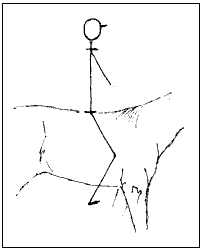
Figure 2.
Finding the Correct Position

Figures 3a and 3b.
Student Listening to Instructor While Practicing "Checking His
Position" by Standing in His Stirrups at the Walk
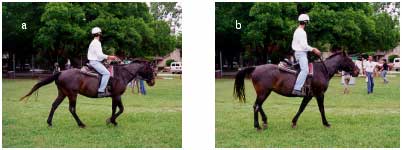
Skill Two: Lowering the Center of Gravity
Joe needs to become aware of where his body weight (i.e., center of gravity) is, because a lower center of gravity will provide a sturdier base. While Joe is standing in his stirrups, he can alternately rise up on his toes and sink down in the heels (without moving the lower legs away from the horse). He can also pinch with his knees, thighs, or the back of his calves to experience how "bracing" can raise his center of gravity (Figure 4) and to note where his weight is located at any time.
Figure 4.
Learning to Find the Center of Gravity
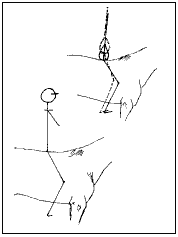
Skill Three: Unlocking the Lower Back
This skill will teach Joe to move side to side with the horse's natural motion, and later, to sit to the trot. After Joe checks his position (Skill One), he can imagine pedaling backwards while seated on a bicycle. This is the motion the horse's back makes at a walk (Figure 5), and Joe can move with the horse by alternately dropping his weight (from the hip) into each heel with the horse's movement. By learning to release stiffness in the spine and to move with the horse at an early stage in riding, Joe will eliminate many bracing problems later on.
Figure 5.
Moving with the Horse at the Walk
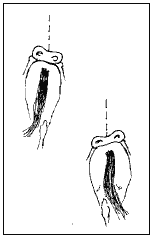
Skill Four: Moving the Upper Body Around and Over a Correctly Placed Leg
These exercises are used to teach Joe to use his seat and legs as an anchor (without bracing or gripping) as he moves his upper body. To teach this skill, familiar "stretching" exercises are used, with the emphasis focused on maintaining a stationary leg. Once Joe has checked his alignment, he must maintain the leg position while touching the horse's ears or tail, or his own toes on both sides with each hand (Figure 6).
Figure 6.
Properly Performed Stretching Exercises
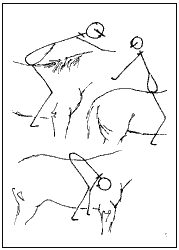
During the toe-touching exercise, the rider must bring his nose to his knee. If he leans out "beside" the horse or steps into the stirrup on that side, he will pull the horse out of balance and possibly fall off (Figure 7). Joe should shift his weight to the opposite seat bone before leaning over (i.e., to the right seat bone prior to leaning left). Recognize that most inexperienced, overweight, and/or geriatric riders may be unable to touch their own toes while mounted, but their flexibility and stability in the saddle will improve with practice.
Figure 7.
Common Mistakes That Occur During Exercises
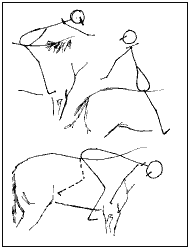
Skill Five: Moving with the Horse at a Trot
Joe will begin with the posting trot (western riders, too) by rising up and then gently sitting back down with each full trotting stride. The cadence will coincide with the movement of the front legs, so that "left, right" will correspond to "up, down." Once Joe can post successfully, he can move to the 2-point position (similar to light seat or jumping position). Joe will simply stand up in his stirrups (without leaning forward or hanging on to the front of the saddle) and allow the horse's trotting motion to shift Joe's weight from side to side (Figure 8). The weight shift is caused by the movement of the horse's hind leg, and Joe's weight shifts to the right just before the right hind hoof leaves the ground (or as the right hind toe breaks over).
Figure 8.
Moving with the Horse's Trotting Motion While in a Standing Position
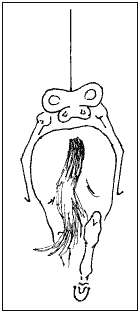
Once Joe can stand and shift his weight with the horse in motion without falling forward or backward, he is ready to sit at a trot. In order to sit to the trot, Joe uses the lateral motion of the horse at the 2-point position, then simply bends his knees and sits, keeping the side-to-side motion going. If he has difficulty, it will be due to one of three causes:
- Joe has not brought his shoulders back over the seat bones when he sits and is leaning slightly forward (Skill One),
- Joe has stiffened his lower back in preparation for (or fear of) of the trot (Skill Three), or
- Joe is pinching with his knees or thighs (Skill Two).
At the beginning, it will probably look sloppy, and it may take several tries before he is able to keep the motion going at the sitting trot.
Skill Six: Gaining Balance over a Stable Lower Leg
This skill is accomplished by performing the "7-7-7 exercise" at the trot (Dawson, 1997). The "7-7-7 exercise" consists of seven strides of each of the following positions repeated continuously: rising, 2-point, and sitting trot. When Joe accomplishes this skill, he will be able to recognize proper positioning and alignment, all unnecessary upper body movement will be gone, and the horse will move freely and comfortably under him.
Results and Discussion
Learning the skills is relatively easy if the instructions are followed exactly, because each consecutive skill builds on the previous one. The first skill, finding and keeping correct body alignment, relates easily to the well-known "ear-shoulder-hip-heel" rule. The Secure SeatSM exercise allows Joe to check his own alignment by simply standing up in the stirrups. If Joe's legs are too far forward, he will have to compensate by leaning forward or grabbing the mane, and if his legs are too far back, Joe will fall forward on the neck.
As Joe moves his lower leg to a more correct position, standing up will become easier. In addition, he will have a more secure seat if the weight is allowed to sink into the seat and heels. Gripping with the knee or thigh will cause Joe to rise slightly and decrease the stability of the seat. If Joe is aware of the center of gravity and knows how to lower his weight in the saddle, he will have a deeper seat. Once that seat is established, Joe can learn to use a backward bicycle motion at the walk, a side-to-side motion at the trot, and a reverse wheel motion with the hip (left hip with left lead) at the lope or canter.
The various stretching-type exercises in Skill Four help Joe become flexible and in control of his upper body and, therefore, more able to recover body position when an unexpected spook occurs. Joe, who is learning to shift from side to side in a 2-point or light-seat position in time with the horse's movement, will at first exaggerate the movement until it can be accomplished consistently.
The sixth and final skill requires stabilizing the leg position and gaining balance over the leg. Riders who can alternate between these positions consistently and maintain the correct alignment and a stable lower leg will have achieved a more stable, safe and comfortable ride for themselves and their horses.
Summary
One of the major concepts that Secure SeatSM teaches is to avoid interfering with the natural movement of the horse. By learning to move with the horse, maintaining a low center of gravity, and being flexible over a stable lower leg, the rider allows the horse to have more natural and comfortable movement. A comfortable horse will be naturally happier and therefore safer for both the horse and its rider.
Acknowledgements
The authors would like to thank Frances Greene, Dr. Ken Duft, and Dr. John McNamara for their critical review of the manuscript.
References
Dawson, J.Z. 1997. Teaching safe horsemanship: A guide to English and Western instruction. Pownal, VT: Storey Communications, Inc.
